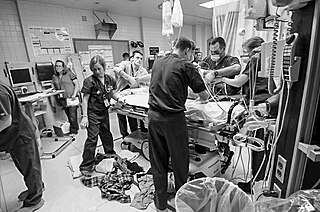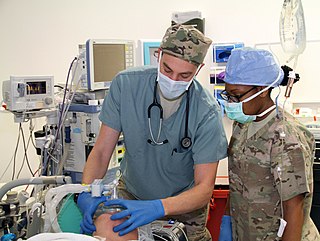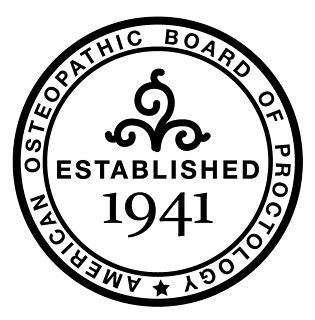
Emergency medicine is the medical speciality concerned with the care of illnesses or injuries requiring immediate medical attention. Emergency physicians continuously learn to care for unscheduled and undifferentiated patients of all ages. As first-line providers, in coordination with Emergency Medical Services, they are primarily responsible for initiating resuscitation and stabilization and performing the initial investigations and interventions necessary to diagnose and treat illnesses or injuries in the acute phase. Emergency physicians generally practise in hospital emergency departments, pre-hospital settings via emergency medical services, and intensive care units. Still, they may also work in primary care settings such as urgent care clinics.

Anesthesiology, anaesthesiology, or anaesthesia is the medical specialty concerned with the total perioperative care of patients before, during and after surgery. It encompasses anesthesia, intensive care medicine, critical emergency medicine, and pain medicine. A physician specialized in anesthesiology is called an anesthesiologist, anaesthesiologist, or anaesthetist, depending on the country. In some countries, the terms are synonymous, while in other countries they refer to different positions, and anesthetist is only used for non-physicians, such as nurse anesthetists.

The American College of Emergency Physicians (ACEP) is a professional organization of emergency medicine physicians in the United States.
Pediatric endocrinology is a medical subspecialty dealing with disorders of the endocrine glands, such as variations of physical growth and sexual development in childhood, diabetes and many more.

The American Osteopathic Association (AOA) is the representative member organization for the more than 176,000 osteopathic medical doctors (D.O.s) and osteopathic medical students in the United States. The AOA is headquartered in Chicago, Illinois, and is involved in post-graduate training for osteopathic physicians. Beginning in 2015, it began accrediting post-graduate education as a committee within the Accreditation Council for Graduate Medical Education, creating a unified accreditation system for all DOs and MDs in the United States. The organization promotes public health, encourages academic scientific research, serves as the primary certifying body for D.O.s overseeing 18 certifying boards, and is the accrediting agency for osteopathic medical schools through its Commission on Osteopathic College Accreditation. As of October 2015, the AOA no longer owns the Healthcare Facilities Accreditation Program (HFAP), which accredited hospitals and other health care facilities.
Established in 1933, the American Board of Medical Specialties (ABMS) is a non-profit organization which represent 24 broad areas of specialty medicine. ABMS is the largest physician-led specialty certification organization in the United States.
Adolescent medicine also known as adolescent and young adult medicine is a medical subspecialty that focuses on care of patients who are in the adolescent period of development. This period begins at puberty and lasts until growth has stopped, at which time adulthood begins. Typically, patients in this age range will be in the last years of middle school up until college graduation. In developed nations, the psychosocial period of adolescence is extended both by an earlier start, as the onset of puberty begins earlier, and a later end, as patients require more years of education or training before they reach economic independence from their parents.
Board certification is the process by which a physician or other professional demonstrates a mastery of advanced knowledge and skills through written, practical, or simulator-based testing.
The American Board of Physician Specialties (ABPS), the official certifying body for the American Association of Physician Specialists (AAPS) is a non-profit umbrella organization for sixteen medical specialty boards that certifies and re-certifies physicians in fourteen medical specialties in the United States and Canada. The ABPS is one of three organizations overseeing Doctor of Medicine (M.D.) and Doctor of Osteopathic Medicine (D.O.) certification in the United States. The ABPS assists its Member Boards in developing and implementing educational and professional standards to evaluate and certify physician specialists. It is recognized by the U.S. Department of Labor as well as the Centers for Medicare and Medicaid Services (CMS).
Established in 1939, the American Osteopathic Association Bureau of Osteopathic Specialists (AOABOS) is a non-profit umbrella organization for 18 medical specialty boards in the United States. Along with the American Board of Medical Specialties (ABMS) and the American Board of Physician Specialties (ABPS), the AOABOS is one of three leading entities that oversees physician board certification in the United States. The AOABOS assists its Member Boards in developing and implementing educational and professional standards to evaluate and certify physician specialists.
Doctor of Osteopathic Medicine is a medical degree conferred by the 38 osteopathic medical schools in the United States. DO and Doctor of Medicine (MD) degrees are equivalent: a DO graduate may become licensed as a physician or surgeon and thus have full medical and surgical practicing rights in all 50 US states. As of 2021, there were 168,701 osteopathic physicians and medical students in DO programs across the United States. Osteopathic medicine emerged historically from osteopathy, but has become a distinct profession.

The American Osteopathic Board of Emergency Medicine (AOBEM) is an organization that provides board certification to qualified Doctors of Osteopathic Medicine who specialize in the medical and surgical treatment of acutely ill patients with advanced cardiac life support, trauma, and the management of other life-threatening medical issues. The AOBEM is one of 18 medical specialty certifying boards of the American Osteopathic Association Bureau of Osteopathic Specialists approved by the American Osteopathic Association (AOA).
In 2006, hospice and palliative medicine was officially recognized by the American Board of Medical Specialties, and is co-sponsored by the American Boards of
The American Osteopathic Board of Preventive Medicine (AOBPM) is an organization that provides board certification to qualified Doctors of Osteopathic Medicine (D.O.) who specialize in aiding patients in the prevention of injury or disease. The board is one of 18 physician medical specialty boards of the American Osteopathic Association Bureau of Osteopathic Specialists of the American Osteopathic Association (AOA). The AOBPM was established in 1982 by approval by the Board of Trustees of the American Osteopathic Association. The AOBPM provides board certification for eligible physicians. Additionally, along with fellows of the American Board of Preventive Medicine, fellows of the American Osteopathic Board of Preventive Medicine are eligible to become fellows of the Undersea and Hyperbaric Medical Society. As of December 2011, 176 osteopathic physicians held active membership with the AOBPM.
The American Osteopathic Board of Neurology and Psychiatry (AOBNP) is an organization that provides board certification to qualified Doctors of Osteopathic Medicine (D.O.) who specialize in disorders of the nervous system (neurologists) and to qualified Doctors of Osteopathic Medicine who specialize in the diagnosis and treatment of mental disorders (psychiatrists).

The American Osteopathic Board of Anesthesiology (AOBA) is an organization that provides board certification to qualified Doctors of Osteopathic Medicine (D.O.) who specialize in the administration of anesthetic agents and perioperative medicine (anesthesiologists). The board is one 16 medical specialty certifying boards of the American Osteopathic Association Bureau of Osteopathic Specialists approved by the American Osteopathic Association (AOA), and was established in 1956. As of October 2019, 720 osteopathic anesthesiologists held active certification with the AOBA. Currently 85 Diplomates have subspecialty certification in Pain Management, 13 in Critical Care Medicine, and 20 in Pediatric Anesthesiology.

The American Osteopathic Board of Pediatrics (AOBP) is an organization that provides board certification to qualified Doctors of Osteopathic Medicine (D.O.) who specialize in the diagnosis and treatment of medical diseases in infants, children, and adolescents (pediatricians). The board is one 18 medical specialty certifying boards of the American Osteopathic Association Bureau of Osteopathic Specialists approved by the American Osteopathic Association (AOA), and was established in 1940. As of December 2011, 477 osteopathic pediatricians held active certification with the AOBP. Fellows of the AOBP are eligible for membership in the American Academy of Pediatrics along with fellows of the American Board of Pediatrics.

The American Osteopathic Board of Proctology (AOBPR) is an organization that provides board certification to qualified Doctors of Osteopathic Medicine (D.O.) who specialize in the medical and surgical treatment of disorders of the anus, colon, and rectum of the gastrointestinal tract (proctologists). The board is one of 18 medical specialty certifying boards of the American Osteopathic Association Bureau of Osteopathic Specialists approved by the American Osteopathic Association (AOA), and was established in 1941. As of April 2011, there were 25 osteopathic proctologists certified by the AOBPR.

The American Board of Pediatrics (ABP) was founded in 1933. It is one of the 24 certifying boards of the American Board of Medical Specialties (ABMS). The ABP is an independent and nonprofit organization. The ABP's mission is to advance child health by certifying pediatricians who meet standards of excellence and are committed to continuous learning and improvement.
The American Board of Pathology (ABPath) is one of 24 member boards of the American Board of Medical Specialties. This organization was assembled in May 1936, under the approval of the Advisory Board for Medical Specialties (ABMS) and the American Medical Association (AMA) Council on Medical Education and Hospitals. It is the duty of the ABPath to grant certification in Anatomic Pathology, Clinical Pathology and/or Anatomic/Neuropathology to qualified Doctors of Medicine and Doctors of Osteopathic Medicine (M.D./D.O.).